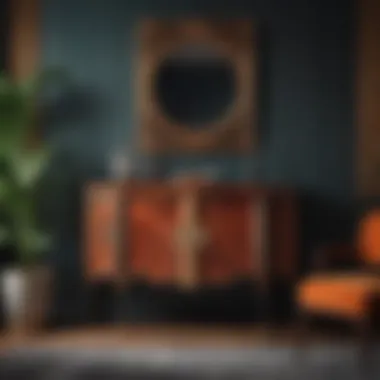Art Deco Furniture Designers: A Closer Look


Intro
Art Deco is not just a design movement; it embodies an era of creativity and innovation in the early 20th century. From the dazzling skyscrapers of New York City to the luxurious interiors of Parisian salons, the influence of Art Deco furniture designers cannot be overstated. This style, characterized by its bold geometric forms and rich materials, serves as a bridge between the ornate aesthetics of the past and the streamlined functionality of the modern age.
In this exploration, we delve deep into the significant figures of Art Deco design. It is essential to understand how these designers interpreted their cultural milieu, and the techniques they developed to create pieces that remain desirable to this day. Every chair, table, and cabinet tells a story of its time, reflecting the aspirations and lifestyle of the people who lived in that era.
Key topics include the artistic principles that guided these designers, the materials that were favored, and the enduring legacy of their works in contemporary interiors.
Home Design Inspiration
Architectural Styles
Art Deco architecture is recognizable for its smooth lines, intricate detailing, and, often, a playful approach to geometry. Tall buildings such as the Chrysler Building exemplify the marriage of functionality and aesthetics, marking this period as one of vibrant urban growth.
With buildings that complement the bold designs of Art Deco furniture, homeowners can draw inspiration from these structures. Elements like streamlined facades and ornamental motifs can influence modern home design, offering a foundation for decor that echoes the elegance of the past.
Innovative Decor Trends
Art Deco furniture design is not simply about looks; it’s also about the innovative techniques employed. Designers such as Émile-Jacques Ruhlmann and Jean-Michel Frank utilized luxurious materials like ebony, chrome, and glass. These selections not only highlight opulence but also contribute to functionality in modern design.
The trend of blending different materials, while still maintaining harmony, is a key takeaway for current designers. For instance, mixing wood finishes with metal accents can create a well-rounded aesthetic that appeals to diverse tastes.
"Art Deco furniture is an elegant fusion of art and functionality, leaving behind a legacy of timeless appeal."
These insights into architectural styles and decor may arouse the imagination of designers and homeowners alike, encouraging them to curate spaces that reflect both historical significance and modern preferences.
Foreword to Art Deco
Art Deco is more than just a style; it is a cultural statement that reflects a distinct period in history. This section introduces the significance of Art Deco to the contemporary design landscape. The style emerges prominently during the early 20th century, intertwining elegance with functional design. This era encapsulated a rebirth of luxury, with designs that emphasized geometric forms and ornamental details.
Understanding Art Deco furnishes a lens through which one can appreciate modern design evolution. The influences of technology and the glamour of the time underpin the practical as well as aesthetic aspects of this style. Designers drew from various fields, including architecture, film, and visual arts, creating a multidimensional facet of interior design that resonates even today.
This exploration aims to foster a deeper understanding of Art Deco's pivotal role. Appreciating its origins and characteristics will help enthusiasts recognize its impact on modern furnishings and overall design principles. Knowing what makes this style unique enriches conversations about furniture design and cultural history.
Origins of Art Deco
The origins of Art Deco trace back to the 1920s and 1930s, aimed at countering the previous movements of Classicism and Art Nouveau. Born in France, Art Deco gained momentum following World War I, representing a desire for renewal and progress. The 1925 Exposition Internationale des Arts Décoratifs et Industriels Modernes in Paris is often credited with popularizing the term "Art Deco." It showcased a variety of objects that celebrated modernity and craftsmanship.
During this time, influences of Cubism, Futurism, and even ancient Egyptian motifs contributed to shaping Art Deco. Global events such as the roaring twenties in America fueled the rise of luxury and ostentation in design. The fascination with speed and technology brought forward motifs reflective of these themes, thus pushing traditional boundaries.
Characteristics of Art Deco Design
Art Deco design is characterized by its rich detailing and streamlined forms. It stood out for its bold geometric shapes, vibrant colors, and the use of luxurious materials. Here are the defining features:
- Geometric shapes: Art Deco utilizes angular shapes that merge both forms and function.
- Material variety: Usage of high-quality materials like chrome, glass, and exotic woods became prominent.
- Colorful palettes: Bright, contrasting colors often bring a sense of vibrancy to pieces.
- Ornamentation: Decorative elements are intrinsic, yet structured, differentiating it from the chaos of earlier styles.
The culmination of these elements results in designs that are both timeless and modern. Art Deco reflects an era that aimed to break away from the past while remaining rooted in elegance.


Iconic Art Deco Furniture Designers
Art Deco represents an intersection between functionality and artistic expression. This section focuses on the furniture designers who greatly influenced this style, contributing to its rich visual language and establishing design standards that resonate through time. Understanding the work of these iconic figures not only illuminates their individual artistry but also contextualizes the broader narrative of the Art Deco movement. Their creations are more than mere objects; they embody cultural sentiment and technological advancements of their era.
Charles Rennie Mackintosh
Charles Rennie Mackintosh is often celebrated as a precursor to the Art Deco movement. His designs exhibit a blend of Scottish heritage and modernity. Mackintosh's notable works include the Hill House and Willow Tea Rooms in Scotland, where his furniture designs display a distinct elegance and geometric purity. His use of handcrafted wood and stained glass set him apart from his contemporaries. This uniqueness often lies in his ability to meld traditional craftsmanship with contemporary aesthetics.
A critical aspect of Mackintosh's work is the interplay of line and form. His furniture often features angularity, which aligns with Art Deco's sharp, stylized motifs. He emphasized functionality without sacrificing ornate detailing, making his pieces suitable for daily use yet appreciated as art.
Jean-Michel Frank
Jean-Michel Frank was a pivotal figure in Art Deco, known for his luxurious and understated style. His dedication to simplicity without compromising integrity marked a significant shift in furniture design. Frank's pieces exude a sense of comfort and elegance, largely due to his use of soft materials and subtle colors.
One of his hallmark designs includes the "Cigar" chair, recognized for its sculptural shape and inviting form. Frank favored natural materials, often employing leather and exotic woods, establishing a connection between both organic and modernist elements. His innovative approach to space formed a crucial dialogue between architecture and furniture, enhancing the overall interior environment.
Emile-Jacques Ruhlmann
Emile-Jacques Ruhlmann is perhaps one of the most esteemed names in Art Deco furniture design. His work is characterized by its grandiosity and opulence. Ruhlmann's mastery of materials stood out; he worked extensively with rare woods, bronze, and ivory, creating pieces that became synonymous with luxury.
Ruhlmann's designs often incorporated streamlined shapes and elaborate curves, reflecting both the influence of industrial design and classical traditions. One of his significant works is the "Cloisonne" side table, which showcases his ability to fuse traditional craftsmanship with modern sensibilities. Ruhlmann exemplified Art Deco's penchant for both extravagance and precision.
Paul Frankl
Paul Frankl, a designer of Austrian origin, brought a different perspective to Art Deco through his emphasis on geometric forms and innovative materials. Notably, he is renowned for his use of “skyscraper” style, which embodies the architectural trends of the 1920s. Frankl's furniture often features bold lines and vibrant colors, setting him apart in the field.
His signature piece, the “Zig-Zag” chair, demonstrates his knack for combining functionality with striking aesthetics. Frankl's ability to engineer furniture that could stand as statement pieces in modern interiors ensured his lasting relevance in design. He interacted dynamically with the space, creating not only furniture but experiences.
Ruhlmann vs. Leleu: A Designer Comparison
When comparing the works of Emile-Jacques Ruhlmann and Jean-Leon Leleu, one observes the divergent paths both took within the Art Deco framework. Ruhlmann pursued grandeur through luxury materials and rich ornamentation. In contrast, Leleu adopted a more stripped-down aesthetic, favoring pragmatic designs that reflected contemporary needs.
Ruhlmann's pieces often feel like museum artifacts; they invite admiration from afar. Conversely, Leleu’s designs, while equally unique, encourage a more personal interaction, offering functionality alongside style. Both designers represent essential viewpoints within Art Deco, illustrating that this movement was not monolithic but rather multifaceted and varied.
Key Features of Art Deco Furniture
The examination of key features in Art Deco furniture is essential to understanding its aesthetic appeal and enduring legacy. Art Deco emerged as a response to the historical demands and social changes of the early 20th century. It fused elegance with modernism, making use of unique materials and geometric forms that set it apart from its predecessors. The distinctive elements of Art Deco furniture reveal the intricate relationship between stylistic choices and their cultural significance.
Materials and Finishes
Art Deco furniture is characterized by its innovative use of materials. Designers often opted for luxurious finishes, which helped convey opulence. Common materials included exotic woods, such as mahogany and ebony, as well as metals like chrome and brass. Glass was also a favored component, not just for its transparency but to add a sense of lightness and elegance. Furthermore, textiles such as silk and velvet were prominent, emphasizing comfort without sacrificing sophistication.
Another noteworthy aspect is the intricate craftsmanship. Many pieces featured inlays or marquetry, revealing a blend of fine artistry and practical form. Such details kept the focus on both quality and visual appeal, a hallmark of the Art Deco movement.
Forms and Silhouettes
The forms and silhouettes of Art Deco furniture highlight the movement's embrace of geometry and streamlined shapes. Unlike the ornate designs of previous styles, Art Deco focused on clean lines and bold angles. Chairs and tables often featured curved or angular constructions, combining functionality with artistic expression.
A distinct feature is the use of bold proportions. Designers created furniture that made a statement, often incorporating asymmetry but still adhering to a rhythm of design that was very appealing. The influence of modern technology and materials also led to designs that felt both contemporary and timeless, resonating with the zeitgeist of the era. Art Deco's philosophy favored a visual balance between elegance and modernity.


Color Palettes in Art Deco
The color palettes prevalent in Art Deco furniture are crucial for establishing the distinctive style. Unlike the muted tones found in earlier movements, Art Deco employed bright, striking colors that often coordinated with the materials used. Deep blues, rich reds, and emerald greens were commonly seen alongside gold and silver accents.
This palette not only highlighted the luxury aspect but also contributed to the overall drama and visual impact. The interplay of colors was meticulously planned to create vibrancy and sophistication, ensuring that each piece captured attention.
The choice of color is often tied to the emotional resonance within the space, enhancing both mood and atmosphere. Collectively, these distinct characteristics of Art Deco furniture work to encapsulate the ideals of an era—combining beauty with practicality, and art with function.
Influence of Art Deco on Modern Design
The influence of Art Deco on modern design is a topic worth exploring, as it illustrates how a historical style continues to resonate in contemporary practices. The Art Deco movement, which characterized much of the early 20th century, blends aesthetics with functionality, shaping current trends in both furniture design and broader interior décor.
Sustainable Practices in Art Deco Revival
A significant aspect of the contemporary revival of Art Deco is its alignment with sustainable practices. Designers today often seek materials that are both luxurious and eco-friendly. This reflects a shift in consciousness towards sustainability in design, which is critical in today’s market.
Art Deco originally featured rich materials like mahogany, ebony, and various metals. Modern designers, however, are increasingly turning to reclaimed woods and environmentally sourced materials. This ensures that the elegance associated with Art Deco can coexist with responsible production methods. The use of bamboo, for instance, offers a sustainable yet visually appealing alternative.
Additionally, many designers emphasize durability in their creations, extending the life of furniture rather than encouraging a throwaway culture. This attitude not only conserves resources but also ensures that quintessential Art Deco elements can be appreciated for many years.
Art Deco in Contemporary Furniture Trends
Modern furniture trends frequently draw on the aesthetics of Art Deco. Geometric shapes, bold colors, and symmetrical forms are now prevalent features in many contemporary designs. Just as Art Deco was about balance and harmony, today's design ethos mirrors this sentiment.
Many designers reference iconic Art Deco elements in their work, blending them with contemporary functions. For instance, furniture pieces might adopt the streamlined forms of the 1920s and 1930s while incorporating modern materials like tempered glass or metal finishes.
Moreover, the color palettes seen in Art Deco — such as deep blues, rich greens, and gold accents — are making a resurgence in modern designs. These colors not only reflect elegance but evoke a sense of nostalgia, appealing to a demographic that values both style and historical significance.
Art Deco reminds us that design can be both functional and beautiful, a principle that remains relevant even in a fast-evolving modern landscape.
In summary, the influence of Art Deco on modern design is evident through its principles and aesthetic choices, which promote both beauty and sustainability. Through this dynamic interplay, contemporary designers breathe new life into an enduring legacy.
The Cultural Context of Art Deco
The cultural context of Art Deco is significant in understanding the movement itself. Emerging in the early 20th century, this design style was shaped by the social, political, and technological currents of its time. It reflects a fusion of progressivism and tradition that defined an era marked by change. The Roaring Twenties, with its economic prosperity and social liberation, provided fertile ground for Art Deco to flourish. This combination of factors facilitated a distinctive aesthetic, characterized by its embrace of modernity while paying homage to classic influences.
Art Deco and the Roaring Twenties
The Roaring Twenties was an era of profound transformation in society. After the hardships of World War I, many people sought to celebrate life, freedom, and the possibilities of a new era. Art Deco emerged as a response to this cultural shift, embodying the exuberance of the period. In design, this was manifested through bold geometric patterns, luxurious materials, and the integration of new technologies.
Key characteristics of Art Deco during this time include:
- Use of Jazz Age Motifs: The influence of jazz music can be seen in the rhythmic patterns and vibrant colors in furniture design.
- Luxury and Glamour: Opulent materials like chrome, glass, and exotic woods were increasingly used, reflecting the newfound wealth and desire for stylish living.
- Streamlining: A focus on sleek forms and functionality symbolized the forward-thinking attitude of the time.
Art Deco not only catered to the upper classes, but it also permeated the mainstream, impacting everything from architecture to clothing. The style encapsulated the spirit of the time, creating a sense of optimism and dynamism.
Art Deco’s Global Reach


The influence of Art Deco extended far beyond its origins in France, reaching various corners of the globe. It became a universal language of design that resonated with different cultures and artistic traditions. Art Deco was not merely a Western phenomenon; it adapted to local contexts and aesthetics.
Noteworthy instances of Art Deco's global impact include:
- United States: The Chrysler Building in New York exemplifies the style’s grandeur, integrating local architectural trends.
- South America: In countries like Brazil, Art Deco embraced local materials and vernacular design, resulting in unique adaptations.
- Asia and Africa: Local crafts and motifs influenced the Art Deco style, creating a blend that respected traditional practices while innovating.
This global interpretation enhances the relevance of Art Deco as a versatile design language, one that holds a mirror to the cultural dynamics of its time.
"Art Deco is a signal of the changes in society itself, a combination of innovative forms and traditional elegance, showing the world in a new light."
In summary, the cultural context of Art Deco—rooted in the Roaring Twenties and its global reach—provides insight into how this style became a lasting fixture in design history. Understanding its origins and influences helps clarify the lasting impact Art Deco continues to have on contemporary design.
Preservation of Art Deco Furniture
Preserving Art Deco furniture represents a critical aspect of maintaining cultural heritage and appreciation for this distinctive design movement. As time advances, the risk of losing unique pieces due to wear, damage, or neglect increases. Ensuring the longevity of these items helps in conserving not only the furniture but also the stories and aesthetics encapsulated in this style. The significance of preservation extends to educating new generations about Art Deco's historical context and its contribution to modern design.
In preserving Art Deco furniture, several elements come to the forefront:
- Historical Value: Each piece tells a story, reflecting the socio-economic conditions of its era. Understanding its significance enhances appreciation.
- Aesthetic Integrity: Maintaining the original design and finishes preserves the aesthetic value, which can be disrupted by improper repairs or alterations.
- Market Demand: Well-preserved pieces often appreciate in value, attracting collectors and enthusiasts alike.
Moreover, there are various benefits associated with preserving Art Deco furniture. Many times, the techniques used in creating these pieces cannot be replicated today. As a result, maintaining their condition helps ensure their continued relevance and charm in modern environments.
However, the preservation of these pieces presents its own unique challenges.
Challenges in Preservation
Preserving Art Deco furniture involves navigating a multitude of challenges, both practical and philosophical. Factors such as aging materials, changing environmental conditions, and varying levels of craftsmanship complicate the process.
Some common challenges include:
- Material Degradation: Many materials used in Art Deco furniture, such as exotic woods and delicate fabrics, can degrade over time. Factors such as humidity, temperature fluctuations, and light exposure can accelerate this degradation.
- Incompatible Repairs: Using modern materials or methods that differ from the original construction can lead to irreversible damage. For instance, using synthetic varnishes on wood may alter the aesthetic or structural integrity of the piece.
- Historical Knowledge Gap: As the original artisans pass away, expertise in the authentic restoration techniques diminishes. Without proper documentation or expertise, there is a risk of misrepresenting the piece during restoration.
Addressing these challenges requires a thoughtful approach. Careful documentation of the furniture’s historical context and state can guide preservation efforts, while collaboration with experienced restoration experts can ensure the right techniques are employed.
Restoration Techniques
Restoration of Art Deco furniture demands a refined approach, balancing modern technology with historical accuracy. Various techniques exist, aimed at reversing the effects of time while respecting the original design intent.
Some effective restoration techniques include:
- Cleaning and Protection: Regularly cleaning surfaces with gentle, appropriate products helps maintain the materials. Applying suitable protective coatings can safeguard against further wear.
- Conservation: In many cases, conservation rather than full restoration is preferable. This approach seeks to stabilize existing materials without completely replacing or altering them, thus preserving the essence of the piece.
- Traditional Craftsmanship: Employing skilled artisans familiar with Art Deco techniques can revitalize pieces. Techniques like veneering and marquetry can be restored for both aesthetic and structural integrity.
For those involved in the preservation of Art Deco furniture, the goal is to maintain these pieces in a manner that honors their heritage while making them accessible for future generations. With an understanding of the challenges and the application of thoughtful restoration techniques, Art Deco furniture can remain a relevant and admired component of our cultural landscape.
"Preservation of Art Deco furniture is not just about keeping the aesthetics alive; it's about honoring a cultural legacy that continues to influence modern design."
End on the Legacy of Art Deco Furniture Designers
The legacy of Art Deco furniture designers is profound and multifaceted. This artistic movement, which came into prominence during the early 20th century, continues to influence modern design, making it essential to appreciate the contributions of its key figures. The qualities of elegance, sophistication, and innovation that characterized Art Deco are still relevant in today’s interior design landscape.
One significant element of this legacy is the seamless merging of function and decorative allure. Designers like Emile-Jacques Ruhlmann and Jean-Michel Frank created pieces that were not only stylish but also practical. Their work set a standard for integrating utility with aesthetics, which contemporary designers frequently strive to achieve. The use of high-quality materials and rich textures has become a hallmark that resonates even in the minimalist approaches prevalent today.
Moreover, Art Deco's global reach signifies its importance. The style transcended cultural barriers, drawing elements from various traditions, and this exchange fostered a richer artistic dialogue. It is essential to recognize how these influences shaped not just the style but also the functionality of furniture designs across different regions, contributing to a collective aesthetic that remains influential.
Art Deco furniture is also viewed as a reflection of the social and economic conditions of its time. The opulence and glamour of this era represented a departure from the austerity that followed the First World War. In this way, the designs encapsulated a spirit of optimism and a desire for luxury, which many might find appealing today. The ability of Art Deco to reflect societal changes provides valuable insights into current trends in the design world.







